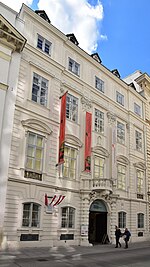Esperanto Museum and Collection of Planned Languages

The Esperanto Museum and Collection of Planned Languages (German: Esperantomuseum und Sammlung für Plansprachen, Esperanto: Esperantomuzeo kaj kolekto por planlingvoj), commonly known as the Esperanto Museum, is a museum for Esperanto and other constructed languages in Vienna, Austria. It was founded in 1927 by Hofrat Hugo Steiner and was incorporated into the Austrian National Library as an independent collection in 1928. Today, it is a museum, library, documentation center, and archive. It accommodates the largest collection of constructed languages in the world and a linguistic research library for language planning. Its catalogue is available online. Since 2005, the museum has been located in the Baroque Palais Mollard-Clary. The museum holds around 35,000 library volumes, 3700 periodical titles, 3500 cultural artifacts, 10,000 autographs and manuscripts, 22,000 photographs and photographic negatives, 1500 posters, and 40,000 pamphlets. Overall, approximately 500 various planned languages are documented, of which the most important is Esperanto.
Excerpt from the Wikipedia article Esperanto Museum and Collection of Planned Languages (License: CC BY-SA 3.0, Authors, Images).Esperanto Museum and Collection of Planned Languages
Minoritenplatz, Vienna Innere Stadt
Geographical coordinates (GPS) Address Nearby Places Show on map
Geographical coordinates (GPS)
| Latitude | Longitude |
|---|---|
| N 48.209444444444 ° | E 16.365277777778 ° |
Address
Bundesministerium für Europa, Integration und Äußeres
Minoritenplatz
1010 Vienna, Innere Stadt
Austria
Open on Google Maps










